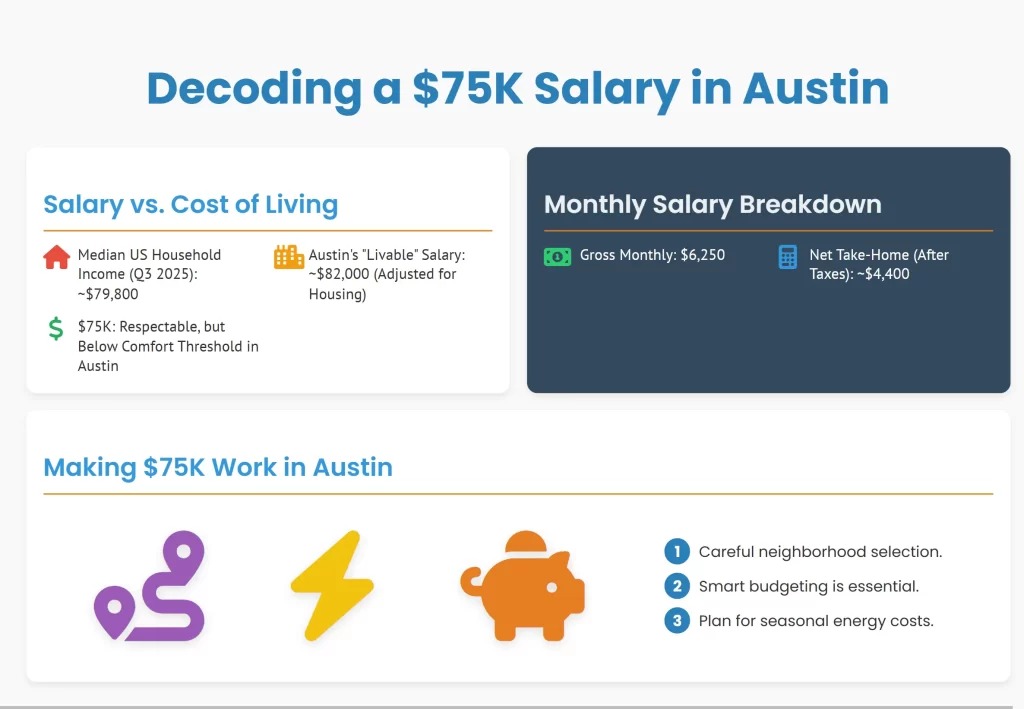Imagine stepping into Austin with a stable job paying $75,000 a year. You’re optimistic—after all, it sounds above national averages. Yet the question lingers: does that income actually stretch far enough to thrive here in September 2025?
The answer lies at the intersection of costs—rent, groceries, taxes, lifestyle choices—and the city’s relentless magnetism. Austin is vibrant, alluring, creative, and, yes, expensive in ways that can surprise even seasoned professionals.
Let’s unpack what $75K buys you, how far it travels in today’s Austin economy, and where it puts you compared to Dallas, Houston, and the U.S. overall.
Get the Austin Neighborhoods Guide here—a resource many new arrivals rely on to bridge budget numbers and lived reality when choosing where to live.
Setting the Frame: Salary vs Cost Reality
According to Bureau of Labor Statistics, Q3 2025, the median U.S. household income sits around $79,800. In Austin, cost indexes adjusted for housing push the effective “livable” individual salary to ~$82,000 before taxes.
That makes $75K respectable but slightly below the recommended local comfort threshold. It allows for a stable lifestyle with caveats: choosing neighborhoods carefully, budgeting weekly categories smartly, and hedging against Austin’s seasonal energy costs.

Where the Salary Goes: Monthly Breakdown
Let’s crunch this salary:
- Gross monthly: $6,250
- Net (after Fed 22%, FICA 7.65%, local nothing, Texas has no state tax): ~ $4,400 take‑home
Here’s the real monthly outlay in Austin, Sept 2025:
| Expense Category | Average Monthly Cost (2025) | Notes |
|---|---|---|
| Housing (1BR) | $1,470 (median) | + utilities |
| Utilities & Internet | $275 | $200 energy+water, $75 internet |
| Transportation | $520 | Car loan, gas, insurance (CapMetro not panacea yet) |
| Groceries | $340 | From USDA/BLS datasets for Austin metro |
| Dining & Leisure | $450 | Typical blend of coffee shops, concerts |
| Healthcare | $365 | Employer plan avg for TX |
| Misc. Household | $220 | Cleaning, subscriptions |
| Savings Target | $550 | (10–12% of gross is healthy target) |
Total ≈ $4,190 — leaving ~$210 cushion.
That margin often collapses once you factor variable costs like unexpected car repairs or seasonal energy spikes.
Contrast vs Dallas & Houston
| City | Median 1BR Rent | Cost Index vs U.S. Avg | How $75K Feels |
|---|---|---|---|
| Austin | $1,470 | 113.5 | Slightly tight |
| Dallas | $1,320 | 107.2 | More breathing room |
| Houston | $1,250 | 105.1 | Easiest fit |
Dallas and Houston stretch $75K further, but Austin’s cultural richness and professional clusters often outweigh higher grocery and rent burdens.
The Housing Decision: Critical Piece
No category erodes $75K faster than rent. In 2025:
- Downtown 1BRs: $1,950–2,300
- Central East lofts: $1,700–1,900
- North Austin (Rundberg, Tech Crescent): $1,250–1,500
- Suburb Pflugerville/Leander 2BRs: $1,850–2,200
This explains why so many shuffle between renting and asking themselves whether a mortgage would actually prove more stable. But remember: at 1.81% effective tax rates across Travis County, a $450K home still adds $678 monthly in property taxes alone—without factoring insurance.
Insight: housing choices, more than groceries or recreation, dictate if $75K suffices or not.
Pair research with the detailed neighborhood guide. It contextualizes rent ranges against lifestyle so you grasp whether that “bargain unit” suits your personal rhythm.
Budgeting Framework: Mapping Your Lifestyle
Let’s illustrate with three personas:
| Persona | Rent Choice | Savings Margin | Lifestyle Comfort |
|---|---|---|---|
| Young Tech Worker | East Austin 1BR @ $1,800 | Ends month ±$50 | Nights out, squeeze on travel |
| Family of 3 | Pflugerville 3BR rental @ $2,300 | Monthly shortfall <$200> | Needs dual income for comfort |
| Solo Professional | North Austin 1BR @ $1,350 | End month +$400 | More balance, lower nightlife |
This underscores a truth: $75K in Austin requires trade‑offs between location prestige vs financial breathing room.
Practical Savings Hacks
- Cut Commuting Burden
Gas + insurance averages $350 monthly. Living closer to CapMetro new rail corridors opening 2026 may significantly reduce this. - Utilities Strategy
Texas heat is relentless. Buy efficient portable AC units or smart thermostats. Both shave off 10–15% long‑term. - Groceries & Kitchen Gear
Preparing meals at home saves $200+ vs heavy dining out habits. Start strong with reliable cookware starter kits.
Bigger Picture: Quality of Life
Even with stretched margins, Austin delivers intangibles. You’ll hear live guitars drifting from Zilker lawns, stroll weekly farmers markets, and find quirky thrift treasures south of Lamar. This lifestyle explains why people accept narrower margins here versus wider wallets in Houston.
Balanced wisely, $75K buys stability tinged with joy—though not extravagance. You won’t vacation abroad quarterly, but you’ll immerse in concerts, new eateries, and the cultural hum unique to Austin.
Looking Forward: The Road to 2026
- Salary Pressures Rising: Tech salaries moderated in 2024, but expected to climb 5% in 2026 with firm rebound.
- Rent Outlook: Analysts predict 2–3% annual rise metro‑wide.
- Cost Index: Grocery inflation expected to settle at ~2%.
Meaning: anyone earning $75K today needs to anticipate future hikes—planning promotions, side gigs, or dual‑income households to hold steady in the years ahead.
Tying It Together
Does $75K “carry you” in Austin 2025? Yes—if you plan neighborhood smartly and temper lifestyle choices. It teeters between stable and constrained, leaving thin safety for savings or emergencies.
Yet the payoff: experiencing a city where creative energy is valued currency, where live music stitches community, where tacos and tech happily share each block.
Build clarity with guides such as:
- Austin Cost of Living
- Best Neighborhoods in Austin
- Moving to Austin overview
- And the widely trusted Austin Neighborhoods Guide for true holistic vision.
Together, they bridge the gap between pure financial math and human experience, helping you answer the only question that counts: Can I truly see myself thriving here?